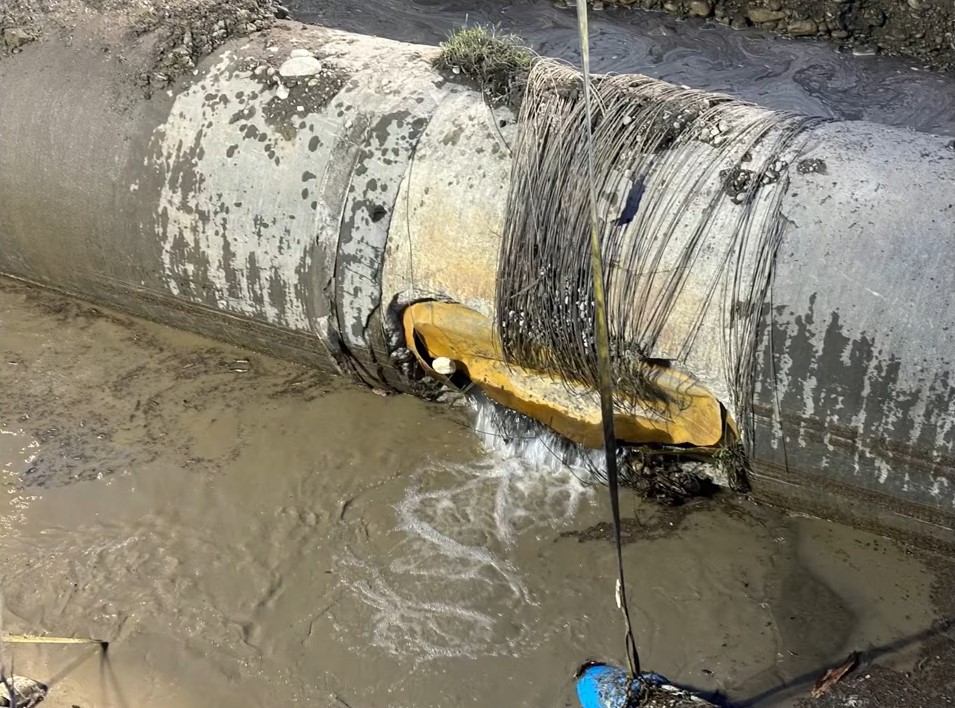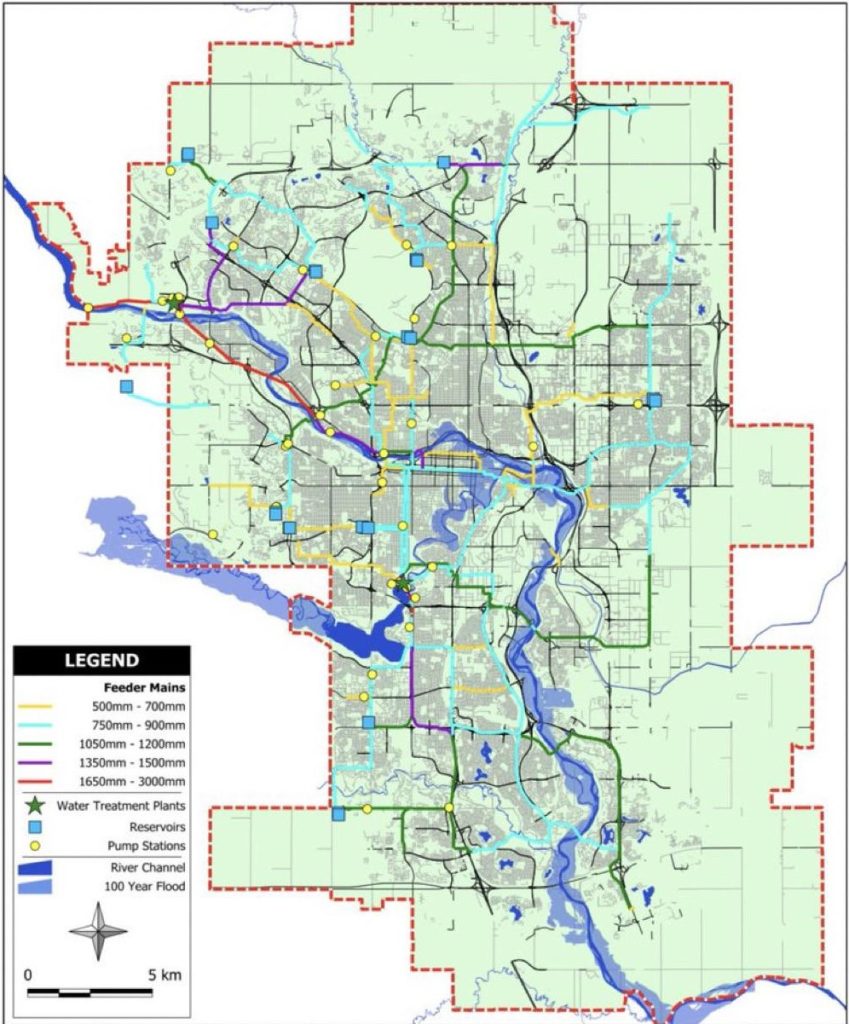As Calgary Mayor Jyoti Gondek continues to ask Calgarians to reduce their water use, she apologized for the city’s communications around the water crisis.
The update Sunday at City Hall saw Gondek not only apologize, but say the city is going to step up its communications, with serval additions that include daily news conferences, infographics, and clear timelines.
“I’m sorry, that information has been slow to come and that it’s been confusing at times. It’s been a stressful situation for everyone involved. And I have heard your concerns,” she told reporters.
“Going forward, we will do a much better job of explaining what’s happened, the expected timeline to get back to normal and what we need from you in the way of water conservation. And that starts now.”
She says there will be daily news conferences at 8:30 p.m. and 2 p.m. every day until this is resolved, and says the city is going to have visuals and graphics that showcase what the situation actually looks like.
“In a nutshell, we need to do a lot better for Calgarians,” Gondek said.
Gondek thanked Calgarians for their efforts in reducing water use, but said it’s important for Calgarians to understand the severity of the situation.
“[Calgarians] took up the challenge and they reduced their water use, and I have to say this again, there’s still people out there that think this is some sort of a joke. They think it’s a conspiracy theory. It is not,” she said.
“If we don’t practice water conservation. We will run out of water, not because it doesn’t exist at the treatment plant. We can’t get it from there to the reservoirs until this piece of infrastructure is fixed.”
Broken feedermain delivers water to 60 per cent of Calgarians

The feedermain that broke is the Bearspaw South Feedermain, which serves 1.2 million people, as well as people in Airdrie, Chestermere, and Strathmore.
Gondek says it provides water to reservoirs in 23 different locations throughout Calgary.
“So think of these reservoirs as tanks that we fill with water. And they are underground, sometimes under soccer fields. And imagine now that you’ve got this tank that’s full, and people are drawing on it, and it’s slowly, slowly coming down. Once it’s empty, it can’t be refilled because the feeder main is broken,” she explained.
“That’s why we could run out of water. That’s why the situation is so critical.”

A map of the City of Calgary’s water infrastructure. The red line in the northwest is the Bearspaw feedermain line. (Courtesy City of Calgary)
Gondek says it’s not a simple repair because there is a difference in size between a main line and a feedermain.
“This is the difference between a water main that’s the size of a pizza versus a water main that you can drive a truck through,” she said. “This feedermain is so big, you could drive a truck through it.”
“So when it broke, it flooded that area of Bowness because there’s pressure pushing that water through the pipe. And so it took time to remove water from the site.”
The feedermain is 11 kilometres long and almost two metres in width, and even though the break occurred in the northwest, the sheer size of the feeder line impacts all Calgarians.
Gondek says once the water was removed, crews were able to go in and inspect the site. Now that that has been done, the city is going to implement a repair plan, which means replacing the broken piece with a replacement one.
“There’s going to have to be some work that’s done. It will involve welding on the inside of the pipe as well as the outside,” Gondek explained.
She says an epoxy material is going to be applied as a seal, and then a tent for the site as heat is needed to keep the seal tight. Then, the pipe can be flushed of debris and officials can ensure the quality is safe.
“That’s why this is all going to take at minimum five to seven days,” she said.
“It is a really big repair job because this piece of infrastructure is so big, and that feedermain is a major artery. This feedermain delivers water to 60 per cent of the city.”
Where is clean drinking water coming from?
In the meantime, water is coming from the Glenmore Water Treatment Plant through a series of pipes, pushing water to 23 reservoirs to “make sure the city has the water it needs.”
“But you got to remember the Glenmore Water Treatment Plant is also supplying water for the other 40 per cent of the city. And all of this is happening underground. So it doesn’t feel real. It’s not something that you can see,” she said.
“So I want you to imagine if you will if a portion of Deerfoot gets shut down, that would impact the entire city, you couldn’t move along that major artery. This is a similar situation. This feedermain break affects the whole city and surrounding municipalities who rely on us for water because we do not have the means to get the water that’s at the Bearspaw Treatment Plant out into those reservoirs.
“That’s why the situation is affecting all of us.”
After Calgarians came together to reduce their water consumption, taking pressure off the Glenmore Water Treatment Plant, Gondek continues to ask residents to reduce their water use.
“Please don’t stop now. Please keep at it,” she said.
The Glenmore Water Treatment Plant produces around 520 million litres of water. Wednesday’s demand was around 650 million litres, which dropped to 520 million litres, and around 484 million litres on Friday.
She says the unverified number for Saturday is 440 million litres. The average water consumption of a Calgarian is 173 litres per day or the equivalent of two full bathtubs.
Water restrictions and ways to reduce water
Gondek says ways to reduce water consumption include shaving time off a shower, forgoing flushing unless needed, and not doing as many loads of laundry.
“Turning off your humidifiers, your ice machines and your automatic sprinkler systems. If you have sprinkler systems systems on a timer, please turn the timers off. Better yet, just turn off the main valve for outside watering,” she said.
Some other ways to reduce water are listed here:
- Using the dishwasher and washing machine only when required and with full loads
- Turning off humidifiers, ice machines and automatic sprinkler systems
- Scraping your plate clean rather than rinsing off food
- Washing vegetables and fruit in a partially filled sink or pot and then rinse them quickly
- Keeping a jug of drinking water in your fridge. Don’t run the tap to get ice-cold water
- Turning off the tap when brushing teeth or shaving
- Limiting showers to five minutes or less and keeping baths shallow
What is happening in Bowness?
The city said early Thursday that 500 homes and 100 businesses in the Bowness area had been affected by the break so far.
Bowness is under a boil water advisory, along with a Stage 4 outdoor water restriction for all Calgarians, they have no clean drinking water.
However, Ward 12 Councillor Evan Spencer said on X that the Bowness Community Association is running low on water bottles and there are families in need.
He is asking residents if they have any to spare to drop them off at 7904 43 Avenue NW, Calgary.
Gondek says bottled water is something the rest of Calgary doesn’t need, as the water that people have access to through their taps is clean drinking water.
“So if you are living in a community that is not Bowness, you are not under a boil water advisory, you have water that is safe, it’s treated water from our facilities, you have that available to you in your taps. Please use that water as you need to remember to conserve it as much as possible,” Gondek said.
“Folks in Bowness do not have that luxury right now. There’s a lot of people with mobility issues and to get them drinking water, we need bottled water. And for the folks that are able-bodied, they’re bringing containers and they’re filling up at the water wagons. So for those of us in communities that are not under a boil water advisory, you don’t need to stockpile bottled water.”
More to come